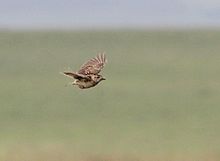Transvaal spur lark
| Transvaal spur lark | ||||||||||||
|---|---|---|---|---|---|---|---|---|---|---|---|---|

Transvaal spur lark, South Africa |
||||||||||||
| Systematics | ||||||||||||
|
||||||||||||
| Scientific name | ||||||||||||
| Heteromirafra ruddi | ||||||||||||
| ( Grant , 1908) |
The Transvaal sporn lark ( Heteromirafra ruddi ) is a species from the lark family. It is a small, short-tailed lark with a noticeably elongated rear claw. Their range is small compared to many other species and is in southern Africa.
The population situation of the Transvaal spurred lark was classified in the IUCN's Red List of Threatened Species in 2016 as " Vulnerable (VU) ".
features
The Transvaal spur lark reaches a body length of about 14 centimeters, of which 3.8 to 4.5 centimeters are on the tail. It weighs about 26 grams. There is no noticeable gender dimorphism .
The Transvaal spur lark has a clear whitish stripe over the eyes on the head. The top of the body is dark brown with whitish mottles. The chin and throat are white. The goiter and front breast are yellowish red with narrow dark brown streaking. The rest of the underside of the body is white to light yellowish brown. The dark brown wings are narrowly lined with reddish. The conspicuously short tail is dark brown. The beak is horn-colored to dark brown, the eyes are hazel brown. The feet are flesh-colored.
The flight song typical of larks consists of small phrases that only last a second and are repeated at intervals of five to six seconds. The singing flight takes between a minute and half an hour. The males either stand shaking in the wind or fly circles with a diameter of 20 to 40 meters.
Distribution area and habitat
The Transvaal spur lark has only a small, island-like distribution area. It occurs in the northeast of the South African province of Free State , in the south of Mpumalanga and in the west of Kwazulu-Natal .
The habitat of the Transvaal spur lark are mountain steppes at altitudes between 1700 and 2200 meters, which have a short, dense sward. It occurs preferentially in regions with precipitation of more than 600 millimeters per year.
Reproduction
The Transvaalsporn lark breeds in the Free State in November, in Mpumalanga in January and in Kwazulu-Natal in October. Like all larks, it is a ground breeder. The nest is cup-shaped and always arched by grass stalks. The clutch consists of two to three eggs. The shell of the eggs is whitish to pinkish yellow and has a dense pattern of gray and light brown dots and spots.
Taxonomy
The Somali spur lark , which is threatened with extinction and only occurs in an area of around 200 square kilometers in Somalia, has long been considered a subspecies of the Transvaal spur lark .
literature
- Rudolf Pätzold: The larks of the world . Westarp Sciences, Magdeburg 1994, ISBN 3-89432-422-8 .
Web links
- Heteromirafra ruddi inthe IUCN Red List of Threatened Species 2016.1. Posted by: BirdLife International, 2016. Retrieved January 3, 2017.

